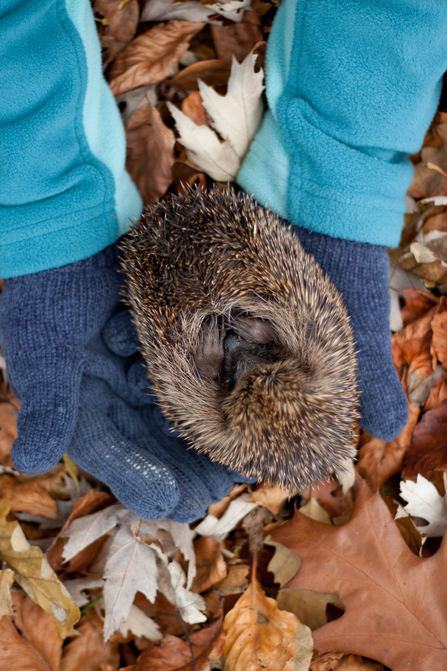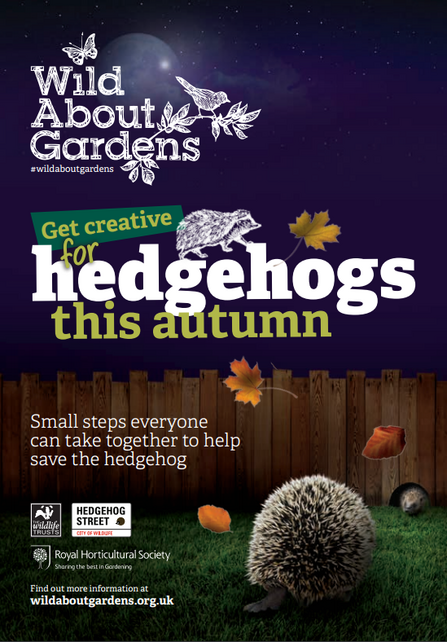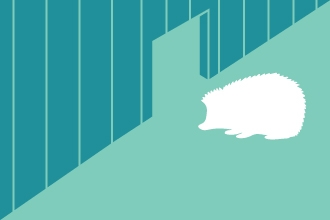Should I try to help a hedgehog?
Hedgehogs usually hibernate between November to mid-March, but they can sometimes be seen out and about during this period changing nesting sites. It is unusual to see a hedgehog around during winter or in daylight, so if you do see one and it looks unwell, it might need a helping hand.
Handling and care
Hedgehogs are wild animals, so being handled is a stressful experience. If you are unsure, contact a specialist group before trying to help.
- British Hedgehog Preservation Society: 01584 890801
- Hedgepigs Nottingham: 07856 165170
If you decide to intervene, here's what to do:

© Tom Marshall
- Prepare a cardboard box with high sides by lining it with a towel or scrunched up newspaper (so that the hedgehog can hide).
- Find yourself a pair of gardening gloves before gently scooping up the hedgehog into the box.
- Keep the box in a quiet, warm place: a hot water bottle filled with hot tap water wrapped in a towel can provide a gentle heat source – make sure it doesn’t go cold!
- You can provide some fresh water and meaty cat or dog food, but don't try to feed the hedgehog directly.
What to do next
If you haven't already, contact The British Hedgehog Preservation Society, who can offer in depth advice and help you find a local rescue centre. Nottinghamshire Wildlife Trust do not offer a general service for care and rehabilitation of sick or injured animals.
How to check your bonfire for hedgehogs
Bonfires are very dangerous for hedgehogs as woodpiles are ideal places for shelter. Sadly many hedgehogs fall foul of un-checked bonfires and are killed because of it. But we can all take steps to ensure bonfires are as safe as possible.
- Build it on the same day that you will light it. The longer it’s left for, the more likely it is that a hedgehog will wander in.
- Place chicken wire one metre high, at an outward angle, all the way around the bottom while you're building it.
- If you have stored materials for your bonfire outdoors then move them to a different patch of ground.
- Always place the bonfire on open ground – never on a pile of leaves as a hedgehog may be hiding underneath.
- Always check the entire bonfire for hedgehogs before lighting it. They tend to hide in the centre and bottom two feet in particular.
- When checking, lift parts of the bonfire section by section using a pole or broom. Do not use a fork, spade or rake as this may injure a hedgehog.
- Use a torch to look inside the bonfire and listen for a hissing sound, as this is the noise that hedgehogs make when they are disturbed or distressed.
- Always light your bonfire from one corner, rather than in the centre, in order to give hedgehogs a chance to escape if they need to.
If you do find a hedgehog then move slowly and calmly. Pick it up with gardening gloves, along with any nesting material it may have been sitting in, and place it in a cardboard box lined with newspaper. Relocate the box to a safe location that is far from any fires or wait until the bonfire is over and dampen down the fire site with water before releasing the hedgehog under a bush or a log pile.
How can you help hedgehogs?
Hedgehogs are found throughout the UK, save a few Scottish islands. Gardens, hedgerows, woodlands, grasslands, parks, and cemeteries are all important hedgehog habitats, and adult hedgehogs travel between 1-2km per night over home ranges between 10-20 hectares in size searching for food and mates – that’s entire housing estates and neighbourhoods!
Why don’t we see hedgehogs?
Hedgehogs are disappearing faster than tigers! Numbers have fallen by nearly a third since 2002. In 1950 the UK population was roughly 30 million, but now fewer than one million are left.
Their decline can be blamed on the loss of hedgerows, over-management of parks and gardens, loss of green space to paving/decking and the use of chemical pesticides, leading to fewer insects for hedgehogs to eat.
How do I know if hedgehogs visit my garden?
Look out for hedgehog poo; medium-sized, black droppings consisting of beetles and other insects, often found on the lawn and looks like a slug!
Make your garden a wildlife haven
Everyone’s contribution is important. Combined, our gardens provide a space for wildlife larger than all our National Nature Reserves, so by gardening in a wildlife-friendly way, we can help our spiky companions move around safely and find a home.
Download our free 'Get creative for hedgehogs' booklet here for more information and inspiration of what you can do to help hedgehogs!

Jon Hawkins - Surrey Hills Photography
Have you seen a hedgehog?
If you have seen a hedgehog dead or alive, please let us know!
We are looking for Nottinghamshire's hedgehog hotspots - the more we know about their distribution, the better we can help these precious creatures.





